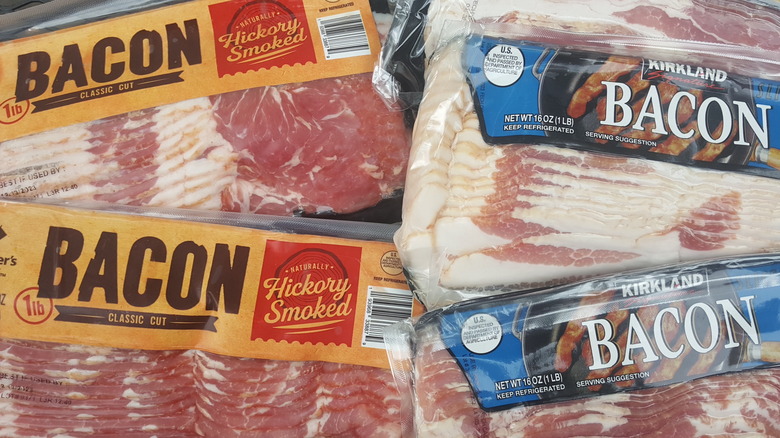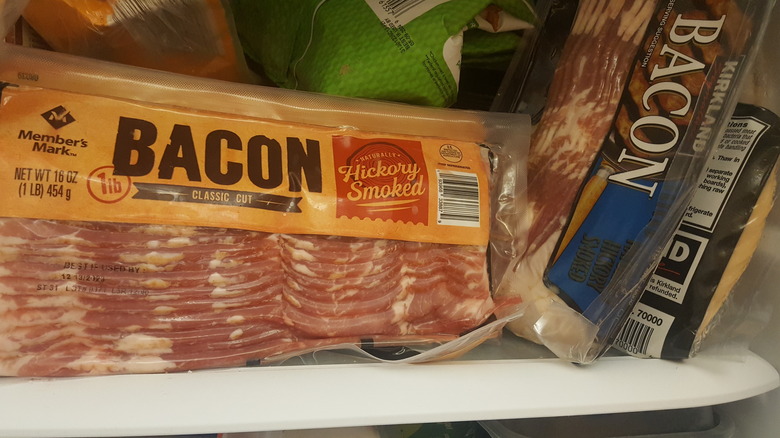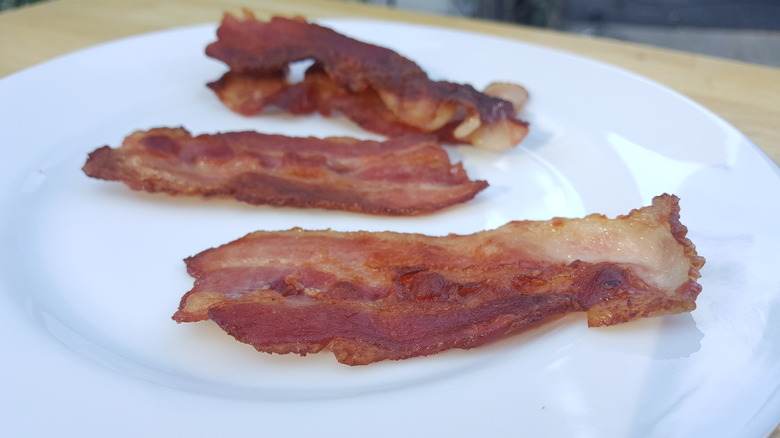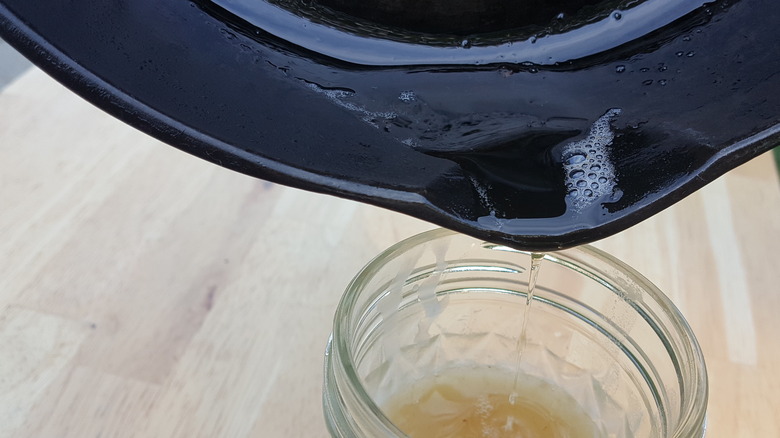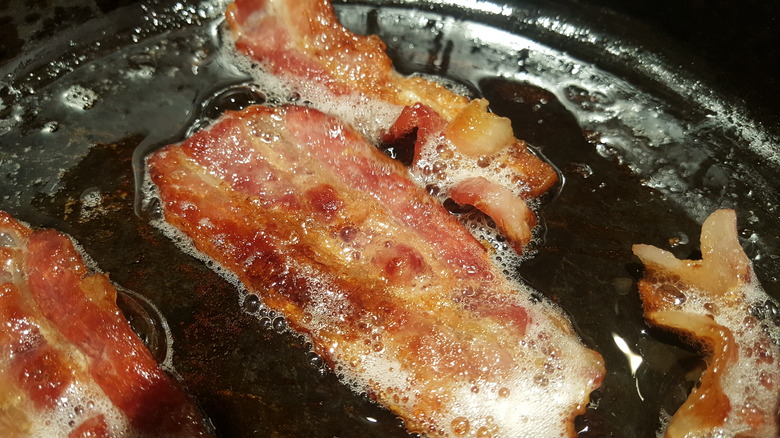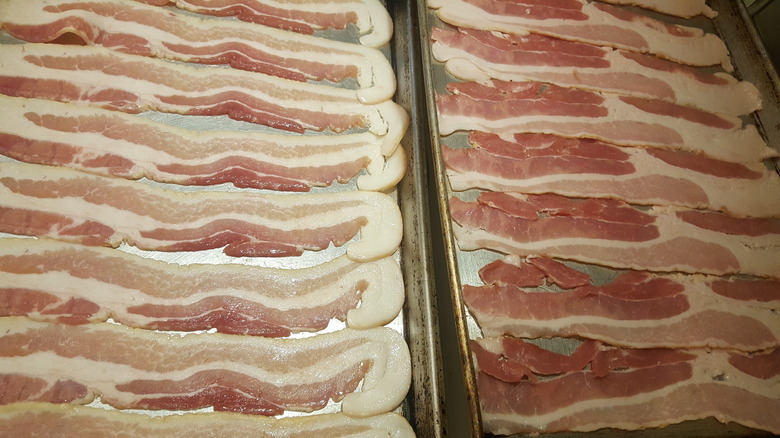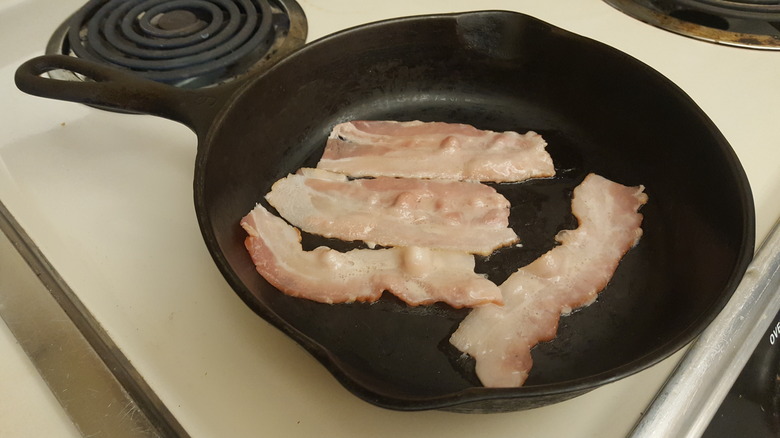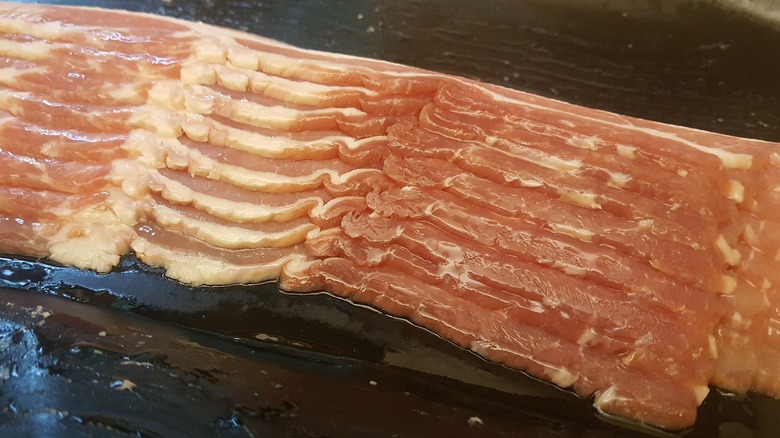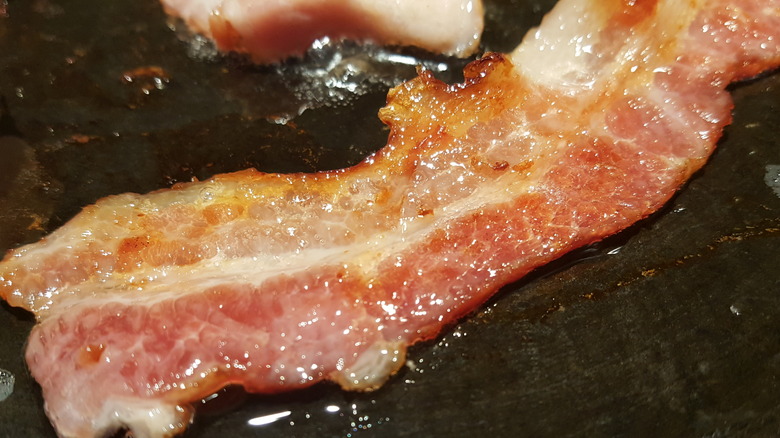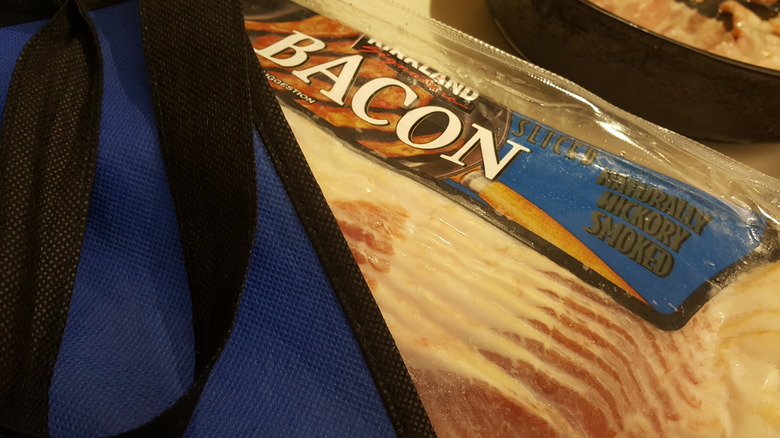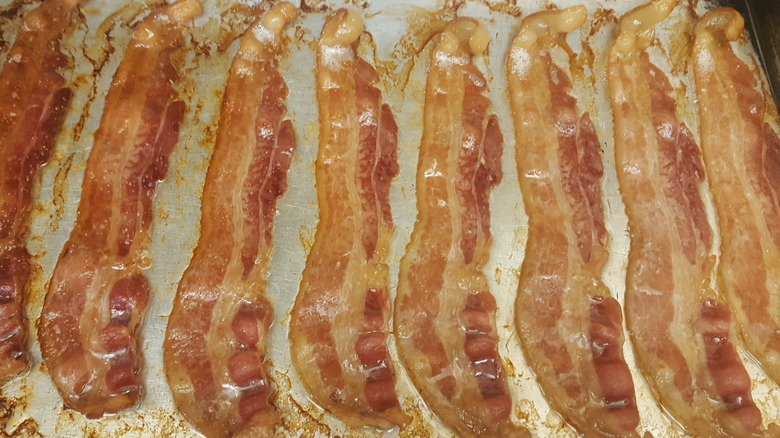Member's Mark Bacon Vs Kirkland Bacon: Which One Should You Buy?
Sam's Club's store brand, Member's Mark, and Kirkland Signature from Costco come to a head again, but this time it's over bacon instead of cheap food court hot dogs or rotisserie chickens. Both brands peddle their version of the pig-based breakfast delicacy, but only one can come out as being the tastiest or cheapest. A thorough taste test and inspection of the competing products could reveal which is preferable, but you may not have the time or energy to do it on your own. Don't worry — if you read this article, you won't have to.
On the other hand, wanting to know which mass-produced, warehouse bacon is tastier could seem like a shallow problem (be thankful for the bacon you have!), but there is good reason to pay attention. Stocking the highest-quality bacon in your fridge is about far more than just the yum factor or saving a few cents. This crispy, salty treat signifies sitting down to a leisurely Saturday morning breakfast with your family. It's the perfect companion to an eggy-cheesy toasted sandwich or a syrup-drenched waffle. Picture yourself taking a rejuvenating sip of coffee with cream and then biting into a piece of bacon while your family chatters around you. It's a relaxing and delicious scene — a delightful moment to savor — and bacon is right there with you. Celebrate that by making sure it's the best bacon it can be.
Kirkland bacon is cheaper per ounce, but the package is bigger
At the time of writing, Costco gives you more bacon for your buck. A 4-pound package of Kirkland goes for about $20 — or $5 per pound. Sam's Club's 3-pound package costs about $16, which comes out to $5.30 per pound. If you ate a pound of Kirkland weekly for a year, you'd save $15. Sadly, saving by buying cheaper bacon probably won't fund that trip to Hawaii.
If 3 or 4 pounds sounds overwhelming, don't worry because both brands vacuum pack each pound separately, so you can store extras in the freezer. Still, bacon doesn't maintain top quality forever, and the National Pork Board recommends refrigeration for up to seven days and just a month in the freezer. That doesn't give breakfast diners much time to use up the multiple pounds they get from the warehouses. Imagine a family of four that eats bacon every Saturday. If each person eats two strips (the recommended serving) it would take them around two months to finish off 4 pounds of bacon. They will have stored the breakfast meat twice as long as suggested.
Bacon is cured so it won't make anyone sick if kept at the correct temperature, but it won't taste as delicious. In that regard, visiting your local Walmart might actually be preferable. There, you can purchase a single pound of Great Value bacon for $5.90, which is just $.60 more per pound than Sam's Club and fresher.
Member's Mark and Kirkland both come out crispy and delicious
Imagine popping the perfect strip of bacon into your mouth. It's crisp on the edges and just the right level of chewy in the center. Both Kirkland and Member's Mark brand bacon have this heavenly texture. What's more important in achieving it is how you cook the bacon, rather than at which warehouse you shop. In fact, using the oven method with strips of Kirkland on one tray and Member's Mark on another results in slices that are wonderfully crunchy and just a little chewy in the middle, especially the ones along the outer edges of the trays.
The oven is an easy method to use to guarantee perfect bacon. Spread some parchment paper on a baking tray and place strips of bacon on top. Place more parchment paper over top to keep the grease from splattering all over, then bake for around 20 minutes at 400 F. If that's not crispy enough for you, leave the bacon in for a few more minutes. The best thing about using the oven instead of a pan is that you can make more strips at one time. If you prefer using a cast iron pan though, then set the burner between low and medium. There's a difference between burnt and crispy bacon, and higher temperatures usually result in the former. Take your time, don't forget to flip the strips, and let them sizzle to the ideal texture.
Kirkland Signature bacon is fattier
The nutrition facts on the back of the packages of bacon from Sam's Club and Costco are telling. Both have 80 calories per two-piece, 17 gram serving size, but in Kirkland's case, three-quarters of those calories come from fat. This brand contains 7 grams of fat and 5 grams of protein per serving while Member's mark has 6 grams of each. From a health perspective, that makes Member's Mark slightly more attractive.
If you are preoccupied with the fat content in bacon, consider an alternative product, for example, turkey bacon. It is also available at Sam's Club and Costco, but not under their store brands. Godshall's version of this product (available at Sam's Club) contains around 45 calories and 2.5 grams of fat per 28-gram serving. That's quite a bit less than the traditional version of the breakfast food. It has a similar cost, though, at around $5 per pound.
Canadian bacon is a second option. The circular slices may not look like bacon, but it tastes similar and the shape makes it easier to add to sandwiches. There are 60 calories in a 51-gram serving of Member's Mark uncured Canadian bacon and there's just 1 gram of fat to 10 grams of protein. The price tag is a little steeper, though — this product costs around $6.50 per pound.
Both brands contain nitrites and nitrates
It's no secret: Bacon doesn't have a great reputation when it comes to health. It's fatty, salty, and terrible for your arteries, but the nitrates in it could be even worse for you. Like most other cured meats, bacon contains high concentrations of this preservative. Your stomach acid can't break down nitrates, and when there are no antioxidants or vitamin C to balance them out, they become nitrites, which are linked to a high risk of cancer and complications during pregnancy (via WebMD).
If you're worried about nitrates or nitrites, avoid Kirkland and Member's Mark — both contain these substances. Of course, all bacon does, so don't be fooled by labels from alternative companies claiming the opposite. Some brands use celery seed or juice as a natural preservative, but it still contains the preservative. In fact, WebMD says some bacon labeled as nitrite-free has double the quantity of nitrates as the regular stuff when measured in the lab.
This doesn't mean you have to give up bacon completely, though. Stick to reasonable serving sizes and eat it occasionally. A 2021 study published in the American Journal of Clinical Nutrition found that processed meats, like bacon, were associated with harmful outcomes in quantities greater than 150 grams per week. To put that in perspective, a two-strip serving weighs around 17 grams. So, you can still eat your Saturday morning bacon and a weekly hot dog, while staying well under that limit.
Member's Mark bacon has larger veins of pink meat
You've probably noticed bacon is marbled with pink meat and white fat, but not all bacon contains the same ratio. The highest quality has less fat and larger, longer veins of pink meat. Look for this characteristic while selecting bacon since it can vary from strip to strip, tray to tray, and brand to brand.
Take a gander at the image above. On the left, you'll see Kirkland bacon, while Member's Mark is on the other tray. The bacon from Sam's Club displays far more pink and less white than the strips sold under Costco's store brand. When comparing these two packages, the bacon on the right would be the better buy — there is significantly more bright red meat in these strips. That doesn't mean Member's Mark will always perform better in this category, though. No two pigs are the same, so it follows that no two pieces or packages of bacon will be either.
If you want to check for pink veins before selecting a tray, neither Member's Mark nor Kirkland makes it especially easy — their packaging doesn't reveal much of the product within. The labeling makes it difficult to see the whole strips and only the bottom half is visible. At least Sam's Club includes a couple of windows on the rear so consumers can get a better view to guide their decision.
Kirkland strips are easier to manipulate
Cooks like to get creative with bacon — think asparagus wrapped in bacon Jamie Oliver-style or bouquets of bacon roses like Camila Alves McConaughey makes for hubby Matthew. If you're getting bacon to use in recipes like these, you don't want just any slice. You need something that's going to be easy to manipulate and won't fall apart while you're at it.
In this category, Kirkland bacon comes out on top — the strips have more attractive, smoother edges and every piece stays together. Some of the slices from Member's Mark, on the other hand, have small pieces of pink meat that separate easily from the rest. That's fine if you're just frying it up for breakfast, but having a strip that's sturdily held together is necessary for more advanced recipes. So, if you're hoping for an Instagramable photo of your gorgeous, bacon-garnished breakfast plate to make your foodie buddies jealous, buy Kirkland.
Thickness is another characteristic to explore. The traditional bacon from the two brands has a similar thickness, which is perfect for producing a crispy texture. If you prefer bacon with a chewier center, then thick-cut could be for you. This variety will also add toothsomeness to broccoli cheese soup, among others. You can get it at either warehouse although not necessarily from the store brands. Kirkland Signature produces this variety, but Member's Mark doesn't. If you're headed to Sam's Club, you'll find thick-cut bacon by brands like Wright and Hormel instead.
Neither brand clarifies the source of its pork
Kirkland and Member's Mark bacon comes from pigs. Their lifestyle — diet and movement — impacts the product's quality, and conscious consumers should take this into account when purchasing meat. Since neither warehouse brand specifies its source, it likely comes from huge industrial pig farms with poor conditions. The provenance of most bacon sold by major brands is similar, and it isn't the best way to obtain a high-quality product.
For example, about 80% of sows spend their lives in crates which seriously restrict their movement, which can be compared to forcing humans to spend a lifetime in an airplane seat. On top of that, industrial hogs eat a diet that sometimes includes grain, chicken manure, and ground-up poultry feathers. The unappetizing mix contains antibiotics to keep the animals from becoming ill from it. Refuse builds up around and under their pens, giving off asphyxiating fumes.
Supporting more hygienic practices doesn't have to break the bank, though. Coleman Natural Foods says its farmers don't use crates — sows have more room to move around and their feed is antibiotic-free. This bacon costs around $6 per 12 ounces (about $8 per pound) at Walmart. On the other hand, if you want bacon from happy pigs that have wandered through green pastures, waded in muddy puddles, and received cuddles from their keeper, head to your local farmers' market instead of a warehouse, but expect to pay even more.
Kirkland Signature bacon tastes saltier, but there's no difference in smokiness
The biggest difference in taste between Kirkland and Member's Mark bacon is the saltiness. Costco's brand tastes distinctly saltier than the competition. Flip over the package and you'll discover the reason why — the sodium content in Kirkland bacon is higher. One serving contains 320 milligrams of sodium versus 270 milligrams in Sam's Club's brand. Now, if you're eating bacon, you probably know you're getting a big dose of salt, so you may not care exactly how high it is. On the other hand, Costco's product seems unnecessarily burdened by the seasoning — Member's Mark is pleasantly salty, not shockingly so.
Insofar as the degree of smokiness, both brands leave something to be desired. You may love bacon because adding just one chopped-up strip to a sofrito with garlic, onion, sweet pepper, and carrot infuses it with a mouthwatering burst of flavor. Unfortunately, both brands are disappointingly bland in this area. They're far saltier than they are smoky, resulting in their presence as an ingredient going somewhat undetected. Make a BLT with either brand of bacon and you'll find yourself wondering if the bacon is missing because the smoky flavor is imperceptible. You may have to try other brands of the breakfast classic until you find one that accents your dishes with the flavor you're dreaming of.
Member's Mark has better packaging
Sam's Club bacon is sold in better packaging than Costco's, with regard to both the size and design. First, Member's Mark bacon comes in a smaller pack, containing 3 pounds instead of 4. That means smaller families or solo individuals don't have to eat as much bacon as fast or require huge spaces in their freezers to store it either. Of course, if you're planning on feeding a big family or serving it at a party, Kirkland's larger pack is more alluring.
The most convenient feature of the Member's Mark bacon package are the windows on the back of the bag. These allow shoppers to inspect the product more carefully before purchasing. Additionally, the Member's Mark's manufacturers have cut each vacuum pack apart and placed the three together in a second, thinner bag. This may produce more trash, but the extra layer means if the packaging gets punctured on the car ride home, there's additional protection to catch the leaking bacon juice. No one wants rancid bacon slime festering in their car.
The four vacuum packs from Kirkland, on the other hand, come in a long plastic strip so you have to cut each pack off the strip before storing or cooking the contents. That's a bit daunting because a single slip of the scissors and you'll have a prematurely opened package of bacon you need to use up quickly.
So, is Member's Mark or Kirkland Bacon a better buy?
Member's Mark bacon wins by a nose in the comparison between the two — but the race is close. The product from Sam's Club is slightly less fatty, contains less sodium, and comes in a more convenient package format. It also has larger veins of pink meat, despite being less visually appealing and more expensive than Kirkland bacon. On most accounts, though, buying one or the other won't make a lot of difference in your dining experience since their taste and texture are so similar. In fact, you likely wouldn't be able to tell if someone changed the brand on you without letting you know.
Most towns and neighborhoods have either a Sam's Club or Costco in the area, and most shoppers choose a membership at one or the other, not both. Ultimately, the most convenient bacon to buy is the one that's nearest and at the warehouse store you usually shop at. If you really are hoping to up the bacon game at your dining table, you may have to look at alternatives to these retail behemoths. Start by checking out a local butcher or calling a livestock farm near you. The cost could be higher, but you'll support your area's economy and more humane farming practices while you're enjoying a crispy strip.
